This page has been compiled to help you, the reader, understand the various Coats-of-Arms that we use. Our Coats-of-Arms were approved by the University Heraldry Committee at their meeting on Wednesday, 14 March 1990 and were subsequently approved by the Senate and Council of the University. The accurate and formal heraldic description (blazon) of the arms is presented in italics, and is followed by the derivation of the coats-of-arms accompanies the text.
Please visit this page for information about the University's coats-of-arms.
The Hall and House coats-of-arms were designed by the heraldic expert, Prof. Hugh Smith on behalf of the University's Heraldry Committee and consist of a shield only, as is the custom with the historic residences on campus, and thus do not possess a mantle or wreath.
Prof Hugh Hamilton Smith, M. Comm. (Unisa), Ph.D. (Rhodes), pictured alongside was an ISER Honorary Fellow and was Head of the Business Administration Department from 1961 - 1981. He was the author of several books, two of which covered heraldry and vexillology. he also served on the Heraldry Council from 1975 - 1984 and was involved with the South African Bureau of Heraldry, where our coats-of-arms are registered (Registration Number: H4/3/1/4059). For more information see:

Prof HH Smith
The Hall is deeply indebted to the late Prof Hugh Smith for the work that he did, as well as to the current Hall Warden at that time, Mrs Coral Waite, who had approached Prof Smith and asked him to design our coats-of-arms. We are also indebted to the staff of the South African Bureau of Heraldry, in particular to Mr Marcel van Rossum (Deputy Director), Mr Gavin Schlemmer (Chief Heraldic Artist) and Mrs Melissa McKenzie (the Heraldic Artist), who at the request of Mr Matthew Charlesworth, a previous Warden in the Hall, worked on the formal registration of our Arms. The official certificates - signed on 7 November 2006 by the National Herald, Mr Themba Mabaso and the Chairpersonof the Heraldry Council, Prof Themba Msimang - were presented by Mr Charlesworth to the Senior Students of the Hall and the individual Houses during a Formal Dinner on 22 August 2007 at which the Vice-Chancellor, Hall Committee, and the students of the Hall and their guests were in attendance.
Azure, two keys in saltire Or, between, in chief a mitre Argent, embellished Or, and Azure, and in base, an escallop also Argent. (South African Bureau of Heraldry Certificate Number: 3604)
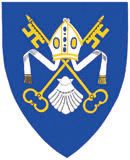
CCOA AWH
The silver scallop shell is taken from the coats-of-arms of Rhodes University to emphasise that the Hall is an integral part of the University. The scallop shell was also the medieval symbol of the pilrim; and by an extension of this concept, may be seen as symbolising the students of the Hall as being pilgrims seeking knowledge.
The armd of the four houses follow a common pattern: the mitre and keys are accommodated on a chief (blazoned as being escartelly dovetailed), with the main field containing a symbol unique to each house. Escartelly means that there is a step (up and down) in the middle of the line of division; dovetailed describes the shape of that step.
Or, a cross paty Azure, having conjoined to each arm a plate fimbriated Azure; on a chief escartelly dovetailed also Azure, two keys in saltire Or, surmounted by a mitre Argent, embellished Or. (South African Bureau of Heraldry Certificate Number: 3603)
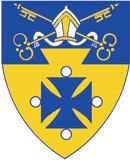
CCOA Canterbury
Or, a fleur-de-lis-Azure; on a chief escartelly dovetailed also Azure, two keys in saltire Or, surmounted by mitre Argent, embellished Or. (South African Bereau of Heraldry Certificate Number: 3601)
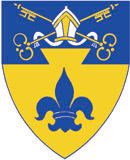
CCOA Truro
Or, a diadem consisting of five rays Azure, issuing from a circlet Argent, embellished Azure; on a chief escartelly dovetailed also Azure, two keys in saltire Or, surmounted by a mitre Argent, embellished Or. (South African Bureau of Heraldry Certificate Number: 3602)
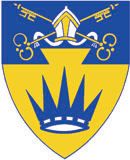
CCOA Salisbury
Or, on a hurt a sun in splendour Or, charged with a rose per pale Argent and Gules; on a chief escartelly dovetailed Azure, two keys in saltire Or, surmounted by a mitre Argent, embellished Or. (South African Bureau of Heraldry Certificate Number: 3600)
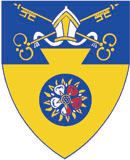
CCOA Winchester

HH Smith signature
For more information about our Coats-of-Arms, please read our entry in Armoria academica. For those interested in learning more about Heraldry, especially about the language or colours used within heraldry, please visit this website run by Mike Oettle of Port Elizabeth who has been a member of the Heraldry Society of Southern Africa since 1998 and is a Fellow and one of three vice-presidents of what is now called the International Association of Amateur Heralds. Also worth a visit is Arthur Radburn's South African Heraldry Website.
Banners for the Hall and the Residences hang in the Dining Hall and appear below:
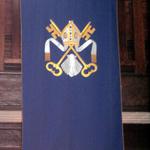
Allan Webb Hall Banner
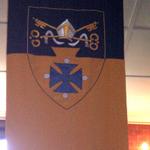
Canterbury House Banner
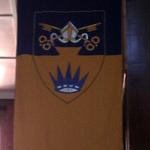
Salisbury House Banner
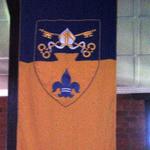
Truro House Banner
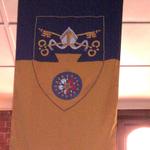
Winchester House Banner
Flags of the Hall and the Residence would appear like the below:
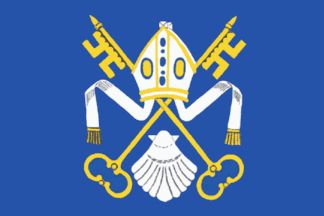
Allan Webb Hall Flag
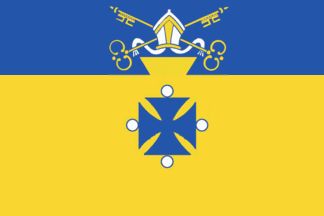
Canterbury Flag
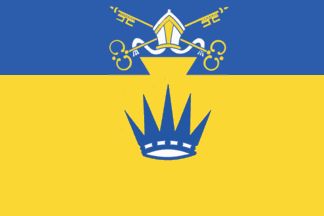
Salisbury Flag
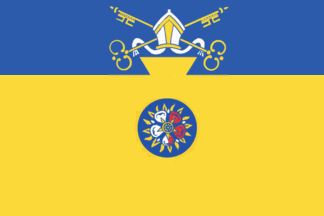
Winchester Flag
Last Modified: Fri, 15 Jul 2011 15:01:12 SAST